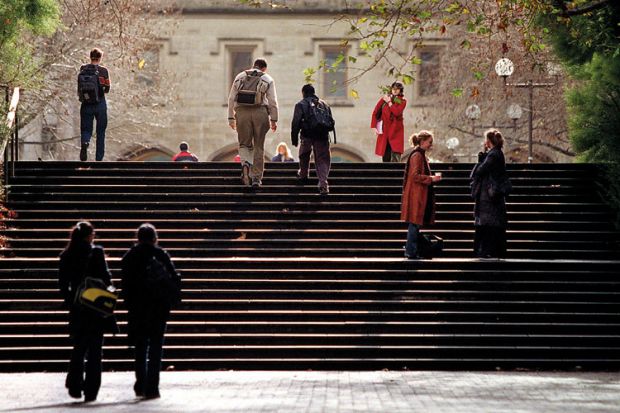View the full World University Rankings 2015-2016 results
Universities are complex organisms. The way literary academics think, work and publish is, for example, very different from the culture for faculty members in engineering or physics, which differs again from the modus operandi in biology. This diversity in expertise is attractive when tackling major issues in a holistic way, but it does make life more difficult when it comes to leadership, particularly achieving any real change in direction.
Muhammad Ali’s injunction to “float like a butterfly, sting like a bee” is pretty much impossible for any university as a complete entity. The way around that is for the university to function as a pedagogic, intellectual and ethical “core” that “anchors” innovation. Change can be very rapid when an operation is small, quarantined by its funding model and with no requirement to teach core courses. Such “cutting-edge” activities can be located in an affiliated institute or centre, or embedded in a traditional university department.
Much of what I know from personal experience about academic leadership relates to a relatively narrow research culture. One basic point is that, in a dedicated research institute, lifetime tenure is a disaster. While an experienced university academic who is no longer driven by curiosity can often find useful administrative and teaching roles in a large university, independent institutes have too few “other” jobs for scientists who have gone off the boil. Interestingly, though, when I look around at top universities, I see a number of outstanding scientists who continue to lead major research programmes while taking on senior administrative tasks. I am in awe of their abilities.
Whether we are talking about leadership of a research institute or a university, one basic rule applies: quality is everything. First-rate people appoint first-rate people; second-rate people appoint third-rate people. That sounds elitist, but it has to be that way, especially for work situations that offer real tenure of contract.
Being employed full-time as a research scientist with the capacity to access and spend large amounts of public or foundation money is an immense privilege that can be made available only to those with the ability and energy to make full use of the opportunity. That is why, even for well-established researchers, it is advisable to limit security of contract to five to seven years, perhaps with a “rolling” review process that allows a three- to five-year phase-out where necessary. Most granting agencies have such mechanisms built into their models, with universities benefiting when both professional salaries and the costs of research are paid for and reviewed externally.
This arrangement has functioned well in the past, but with growing financial constraints on national governments and an academic model committed to continuing expansion via prolific PhD training, the cracks are showing everywhere.
Is there an alternative to funding individual research investigators on the basis of external peer review? Handing research money to an institution can work, but this model requires consistent, high-quality leadership and a process of rigorous (and ruthless) internal evaluation, combined with regular external review. Even so, by providing a greater sense of security, “hard money” funding can serve to limit group size and facilitate excellent research: a prime example is the extraordinary MRC Laboratory of Molecular Biology at the University of Cambridge.
Small can be beautiful, especially in the biomedical sciences: take the Howard Hughes Medical Institute’s “in-house” Janelia Research Campus in Ashburn, Virginia, which features laboratories of up to six people.
Used more broadly, the idea of limiting individual programmes while devolving leadership “down the line” can encourage researchers to collaborate across disciplinary boundaries, break down silos and drive a dynamic research culture. However, it does require the institution to have adequate independent resources to maintain key services, major equipment and the people to run complex, specialised instrumentation.
Strong institutions are central to the health of any advanced society. My personal view is that, working in association with affiliated research institutes, innovative industry partners, citizen groups and governments, the modern research university is our most powerful instrument for promoting human well-being.
Facing challenges such as anthropogenic global warming, rapid environmental degradation and resource depletion, we can ensure a decent future for our (and other) species only if we use the full power of the sciences, including the social sciences, to promote technical innovation and societal change. That requires flexibility, integrity and enlightened leadership at every level.
Peter C. Doherty
Professor of microbiology and immunology at the University of Melbourne
Peter Doherty was awarded the Nobel Prize in Physiology or Medicine in 1996.
Register to continue
Why register?
- Registration is free and only takes a moment
- Once registered, you can read 3 articles a month
- Sign up for our newsletter
Subscribe
Or subscribe for unlimited access to:
- Unlimited access to news, views, insights & reviews
- Digital editions
- Digital access to THE’s university and college rankings analysis
Already registered or a current subscriber? Login




